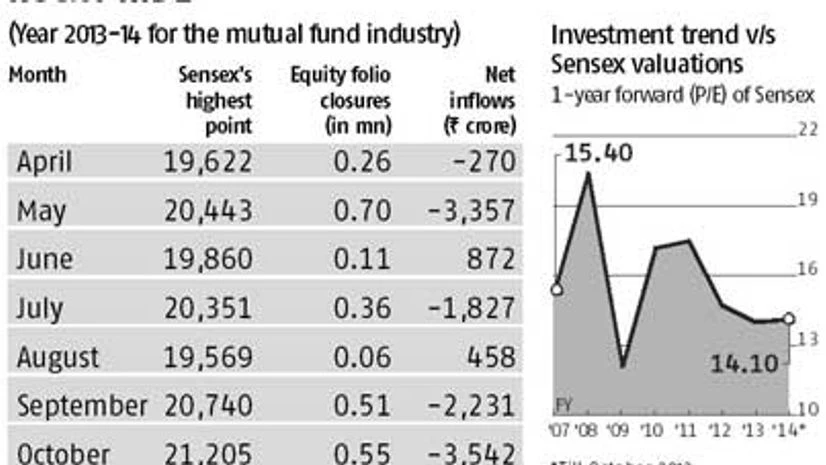India's retail investors, who access stock markets through mutual funds, are redeeming heavily as the Sensex hovers between 20,000 and 21,000. But are they actually making money on their investments? Experts say this kind of investment behaviour wherein one buys at a higher valuation and sells at a far lower valuation is an obvious recipe for poor returns. According to them, rather than redeeming one should keep investing when the valuations are cheaper than the 15-year average.
Prashant Jain, executive director and chief investment officer (CIO), HDFC Mutual Fund, had told Business Standard earlier this year, "A vast majority of investments in mutual funds have come in after the markets have gone up substantially and when the markets are expensive. On the other hand, redemptions are more at lower P/Es. Such an approach to investments does not lead to good returns."
Consider this: The equity segment (including equity-linked savings schemes or ELSS) of the mutual fund industry had the highest net inflows of close to Rs 47,000 crore in financial year 2007-08. During that year, the average forward price to earning (P/E) stood at 20.4.
This only declined in the following years and dipped into negative territory as valuations fell to as low as 14 (P/E). For instance, in FY11 when the average valuation of Sensex was at 17.5, there were net outflows of Rs 13,100 crore while in FY13 when valuations further plunged to 14, investors chose to quit. Net outflows from equities surged to Rs 14,600 crore - a record high.
"What one does feel disappointed about is the mistiming of investments by a majority of investors," adds Jain. In 2013-14, the Sensex crossed 20,000 several times and even scaled 21,000. In a mere seven months (April-October), close to Rs 10,000 crore flowed out. Though the indices may have regained their previous peaks, what is worrying is that the valuation differential is quite high.

Navneet Munot, CIO at SBI Mutual Fund, agrees with Jain. "This is not the right way to make money. We keep suggesting that it is not good to time the market. Systematic Investment Plans (SIPs) are the best tool to invest when valuations are low," says Munot.
In the past few years, the industry has lost close to 10 million equity folios. Most of the fall has come in recent times as indices inched closer to their historic peaks. The current year, so far, has recorded around 2.5 million equity folio closures.
According to Jain, investors should practise low PE investing. As long as the PEs are low or reasonable (in the range of 17-18), they should invest regularly with a medium to long-term view and not invest or reduce exposure at higher P/Es (20-25) in phases, he adds.
Industry officials say it is wrong to go solely by index levels. Despite the Sensex being around 21,000, there are several counters trading at half the price compared to their respective peaks.
According to S Naren, CIO at ICICI Prudential Mutual Fund, it is not only equities that are affected; fixed-income products have problems too. "When the 10-year bond yield was 7.5per cent, investors were investing. Today, when it is 9 per cent they are not willing to invest," he says.

)
